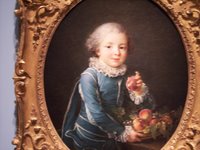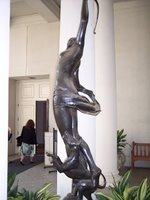Outside Assignment: The Museum




 The American Heritage Dictionary defines "museum" as "...a place devoted to the acquisition, study, and exhibition of objects of scientific, historical, or artistic value". Its derivation is from the Greek word for "Shrine of the Muses" (Mouseion). In Greek Mythology, Zeus, king of the gods, had nine daughters, muses, who presided over different arts and sciences. They were to inspire artists and poets of old and maybe even today. Cynthia Freeland, a modern muse and author of "But is it Art?: An Introduction to Art Theory" in a chapter on "Money, Markets and Museums" raises the question: "Museums preserve, collect, and educate the public and convey standards about art's value and quality- but whose standards, and how?" Are museums just repositories for valuable objects? Can they still be places to have meaningful experiences? Are they responsive to the new challenges of our society or are they too traditional and frozen in the values of the past?
The American Heritage Dictionary defines "museum" as "...a place devoted to the acquisition, study, and exhibition of objects of scientific, historical, or artistic value". Its derivation is from the Greek word for "Shrine of the Muses" (Mouseion). In Greek Mythology, Zeus, king of the gods, had nine daughters, muses, who presided over different arts and sciences. They were to inspire artists and poets of old and maybe even today. Cynthia Freeland, a modern muse and author of "But is it Art?: An Introduction to Art Theory" in a chapter on "Money, Markets and Museums" raises the question: "Museums preserve, collect, and educate the public and convey standards about art's value and quality- but whose standards, and how?" Are museums just repositories for valuable objects? Can they still be places to have meaningful experiences? Are they responsive to the new challenges of our society or are they too traditional and frozen in the values of the past?To begin to answer these questions for myself, I decided to investigate two of our traditional American Institutions which are synonymous with the word "museum". Webster's New World (Roget's)A-Z Thesaurus lists my two choices among more than thirty others worldwide. The Huntington Library, Art Collections and Botanic Gardens in Pasadena, CA (San Marino) and The Smithsonian Institution's American Art Museum in Washington, D.C. have actually been my choices for years. As a child, I remember my parents taking me several times to see "Pinky" and "Blue Boy" at the Huntington's main residence, their actual home. It was always on a Sunday afternoon and usually with out-of-town house guests to impress. I was also impressed- mainly with the wealth of the Huntingtons. In the Naval Air I had the opportunity to fly to Washington, D.C. and time off to visit the Smithsonian. Again, I was impressed with the immense wealth and privilege that must have created and maintained such displays. In the years that followed, as a teacher, I was able to bring my students on annual field trips to the Huntington. I found grants and funding to attend the special Summer Prep. Classes for teachers for the next semester's visit. We rotated our visits to the galleries and gardens every other year. My wife and I joined as "Sustaining and Senior Members". We probably visited at least four times a year (seasonally) and checked out the new exhibits. We watched the New Conservatory being built and took "Flat Stanley" on a trip to the Children's Garden for our grandchildren's benefit. (see previous blog/post in March of '06) I have subscribed to the "Smithsonian Magazine" for many years and have used it in my lessons.
Over the years I have noticed changes in these institutions; not only in the displays but in their support and funding. Beginning, as they both did, as "private collections" of wealthy business men/families, they have had to adjust and adapt to the demands and tastes of their growing and changing public supporters and requirements of governmental and private funding. The most recent project at the Huntington, as mentioned in my blog/post, is the New Chinese Gardens and Art Display (see Huntington website). So many of the current patrons and supporters of the Huntington who actually live in the area have Asian Ancestry. The first Chinese to come to the U.S. were "employed" (enslaved) by industrialists like the Huntingtons to help build the Transcontinental Railroad and other infrastructure that made them so wealthy. They have had to offer more interactive exhibits for younger people in order to stimulate their interest and get the "educational funding" various "Title Funds" require. They have had to increase their "market-ability" with attached gift shops and on-line access. We love to have "High Tea" at the Huntington's Tea Room. We always check out the annual "plant sale" from the Huntington Gardens. Yes, I believe that these two traditional museums have had to adapt to "stay alive" and that their "public supporters" (like me) have had to stay actively involved in their programs and exhibits. I find my on-line membership and visits are less involving but interesting. They keep me in touch with what's going on at both institutions ie. performances, lectures, etc. For the actual, visual enjoyment of the art I have to make the trip in person and that is what my wife and I did last weekend at the Huntington. (see included photos)
After renewing our membership we walked right by the sign on the fenced off Art Gallery We approached the ionic columns of the Scott/Boone Gallery with excitement. We were stepping back into history ie. An ancient Roman Domus "fauces". Next to the "impluvium" was this inspiring sculpture of "Diana the Huntress". We are "moon children" (Cancers) so we were thrilled to see her crescent moon headdress. I had read in Gardner that she is sometimes called "Artemis"(Gr.) "Selene-Luna". We later found her again twice inside the Erburu, miniature and a nude, black bronze over 6' tall without the moon. The friendly/informative guard told us it was rare to see her nude and hunting(she had her bow and arrow in each hand and was balancing on her right foot. Might she be our muse today as we hunted for more "inspiration"? How about the "Blue Hourse" at the Smithsonian's website.
I was then shocked and spellbound by "Vesuvius from Portici". It was just as I had imagined it back in May '06 as I stood on the crumbled ruins of the forum at Pompeii and took pictures of the, now dormant volcano. The artist had seen smoke still rising from the cone in 1774, seven years after it had erupted again. I noticed the white-hot magma and compared it to the serenely white full moon in the lower left. I was awed at the tragic spectacle and yet delighted at the surreal composition of the landscape. It must've been just like that! (see Pliny the Younger's eye witness account in Gardner)
My wife called me over to feast on the rich portrait of "Boy with Peaches" Considered the best painter of children in France at the time, Drouais put life, transparency, humility and charm into his eyes. Peaches symbolize "truth" thus "out of the mouths of babes..." It was then I realized that "children" (all the ones I taught over the years)have been my muses. Oh, I've had some congress with "Calliope", "Terpsichore" and "Thalia" because I loved teaching the Arts, especially Performing Arts.
We then revisited the new Chinese Gardens which are partially done and the "Chrysanthemums of the Eastern Hedge". We would like to bring our new daughter-in-law to see these. She is my oldest son's new muse.
Yes, Cynthia Freeland, I believe the Huntington "standards" over the years have done the job for me and my family even when the kids were "Sick" and we were "Looking for the Mountain" (Smithsonian website) Bob!

2 Comments:
Here are the website addresses of the comparable works of art from the Smithsonian's American Art Museum: "Vaquero" http://americanart.si.edu/collections/tours/jimenez/index.html
"Looking for the Mountain" http://americanart.si.edu/collections/tours/steir/index.html
"The Sick Child" http://americanart.si.edu/collections/tours/francisco/index.html
These are the "Director's Choices" and mine too. Bob!
Here is some more interesting info. on "Diana/Artemis" She was a twin of "Apollo" the sun god, figures if she is the moon god. She was the goddess of the hunt and wild animals. She and her brother are the subjects of Polygnotos's Red Figure Krater Called "Niobid Painter" It depicts the massacre of the 12 (tribes)no children of Niobe. She made the mistake of boasting that she and her kids were better than Leto, Diana and Apollo's mother. Leto sent her twins to punish her for her "hubris" (arrogance). It is a first of interactive, w/ landscape and positions in 3/4 view. It was considered better than works of Euphronia and Euthymedes. Still learning from the Greeks. Bob!
Post a Comment
<< Home